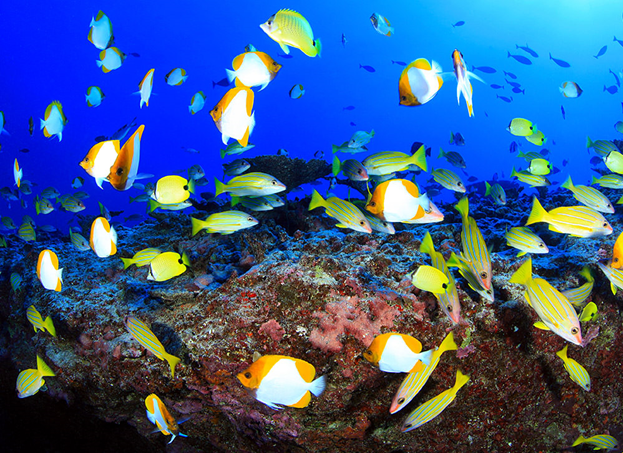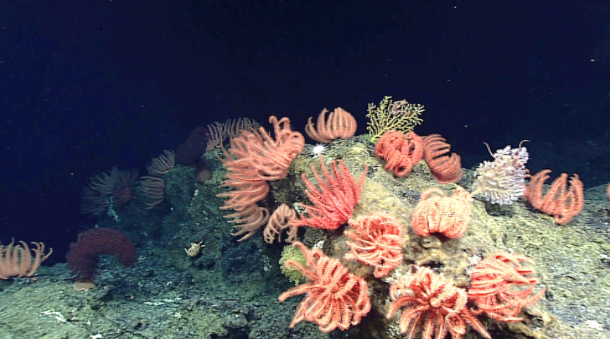
Last Friday, the President expanded the Papahānaumokuākea Marine National Monument near Hawaii to create the world’s largest marine protected area. A marine national monument safeguards ecological resources and unique ecosystems by removing human caused stresses like mining and commercial fishing. The President’s expansion of the Papahānaumokuākea monument provides critical protection for thousands of marine and endangered species. It will also protect deep sea marine habitats, important ecological resources, and pristine coral reefs. The action, which more than quadruples the size of the existing marine monument, is a major step towards ensuring that our Nation’s—and our planet’s—unique marine ecosystems remain vibrant and protected for generations to come.
Since the creation of the Papahānaumokuākea monument in 2006, scientific exploration and research have discovered new deep sea habitats and species. You can witness the incredible diversity of life under the sea in the Papahānaumokuākea monument by checking out this video from the National Oceanic and Atmospheric Administration’s (NOAA) ship Okeanos Explorer.

Designation of the Papahānaumokuākea Marine National Monument for marine protection is all the more important given the expected impacts of climate change on the area’s fragile ecosystem. Earlier this summer, NOAA released a Climate Change Vulnerability Assessment for the Papahānaumokuākea Marine National Monument. Dr. Dan Polhemus, a co-author of the NOAA report, noted that “Existing evidence suggests that the monument’s northernmost atolls may be among the first ecosystems to be irrevocably impacted by global climate change.”
The Assessment found that many climate-related changes are expected to significantly affect the marine ecosystem in the monument and in its vicinity. These include the effects of warmer water on marine organisms; the effects of ocean acidification (resulting from sea water’s absorption of some of the excess carbon dioxide in the atmosphere) on corals and other marine creatures that make their shells or skeletons from calcium carbonate; and the effects of sea-level rise and increasingly powerful storms on shallow-ocean and low-lying coastal ecosystems.
There are two main reasons that establishing marine protected areas—and making existing ones larger—will increase the resilience to climate change of marine ecosystems like those in the Papahānaumokuākea Marine National Monument.
- First, marine ecosystems all around the planet are being threatened by multiple stresses in combination—not just those related to climate change, but also overfishing, ship traffic and the pollution that accompanies it, invasive species, toxic algal blooms, oxygen depletion, and more. These non-climate-related stresses interact with each other and with climate-induced stresses to create impacts that are greater than the sum of the impacts they would have individually. Marine protected areas, by removing or reducing some of those stresses (most notably those connected commercial resource extraction), reduce the total stresses significantly and thereby increase the chance that the ecosystems will be able to cope with the stresses contributed by climate change.
- Second, no matter what the combination of stresses with which an ecosystem must cope, the larger the area that is protected from some of them, the greater the resilience of the ecosystem against the stresses that remain. President Obama’s more than four-fold expansion of the Papahānaumokuākea Marine National Monument will significantly increase the resilience of its marine and island ecosystems against the stresses related to climate change.
In short, marine reserves support climate resilience. Expanding the Papahānaumokuākea Marine National Monument will protect ocean ecosystems for future generations.

Designating and expanding national marine monuments are just a couple of the many actions the President is taking in the realm of sensible management of marine resources. Much of the Administration’s effort in this domain is taking place under the rubric of the National Ocean Policy announced by the President in July 2010. The interagency National Ocean Council created under that policy is working with state and local governments, the private sector, non-governmental organizations, and other stakeholders to craft regional marine plans for sensible, integrated management of marine and coastal resources to benefit economies and nature alike (See here and here for the Nation’s first and second draft regional marine plans).
In addition, as an outgrowth of the “Our Ocean” conferences inaugurated by the Department of State, the Administration is leading international efforts to expand marine protected areas worldwide; to reduce marine pollution; and to combat illegal, unregulated, and unreported fishing. Taken together, the Administration’s ocean stewardship actions, based on the best current scientific understandings, are helping to ensure that our ocean environments remain resilient and thriving resources for generations to come.
Dr. John P. Holdren is Assistant to the President for Science and Technology, Director of the Office of Science and Technology Policy, and Co-Chair of the interagency National Ocean Council.


